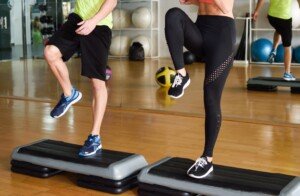Do you wash dishes full-time and wonder if this means you don’t need to exercise in the traditional way, such as aerobics or weight training?
When one washes dishes as their full-time job, they are on their feet the entire time other than for breaks.
Their hands and arms are in constant motion.
What’s more important, though, is that they aren’t sitting for most of the day.
Thus, as far as while they’re on the job, they’re not engaging in the “sitting disease.”
Excess sitting is bad for the body, so if this can be mostly avoided at work, that’s great.
However, being on one’s feet all day doesn’t necessarily translate to getting adequate cardiovascular and weight-bearing exercise.
If you wash dishes for a living, you are not getting enough exercise, nor are you getting the right kind of exercise – even though this line of work totally combats the sitting disease.
Washing Dishes for Work vs. Traditional Exercise
“On your feet” doesn’t mean aerobic workout. Yes, your feet are constantly moving about, shifting, changing direction, etc. This is a lot better than sitting.
But let’s not use sitting all day as a standard, because that’s a pretty low standard.
Aerobic or cardio exercise should be sustained nonstop for at least 20 minutes if done in steady-state or fixed-paced fashion, maintaining an elevated heart rate.
Examples are brisk walking, walking an inclined trail, using a pedaling machine, taking a cardio class, jogging, inline skating and hitting a heavy bag.

Freepik.com, javi_indy
The way you’d feel after performing any of these activities for 20 nonstop minutes is certainly not the way you feel after 20 minutes of doing dishwashing tasks.
Sure, your heart rate is more elevated while washing dishes, carrying carts full of dirty dishes, etc., but this elevation is relative to what it is while sitting, and won’t do much to improve cardiovascular fitness.
No progressive component. In conventional aerobic exercise, the goal is to improve performance over time.
This means if you can’t jog nonstop for 10 minutes, to eventually gain enough stamina to do this. As the exercise gets easier, you increase the workload.
This can be in the form of incline level; speed of walking, pedaling or stepping; and/or length of session.
When washing dishes, you move as fast as you can to get the job done, and there’s a big limit to just how fast you can move, due to the nature of the work and environment.
The floor is always flat. You can’t jog through a dining area while carrying troughs of dishes. You certainly can’t jump. Thus, there are speed restrictions.
Next, the dishes never get heavier. There’s absolutely zero opportunity for a strength training aspect.
The troughs can be loaded only so much. Dishes, pots and pans never get heavier.
They’re light to begin with and stay that way. There’s very little for the musculoskeletal system to adapt to.
You can be washing dishes for 12 months straight with no increase in load; no progressive resistance, which is key to achieving results from weight-bearing activity.
Asymmetrical motions. When doing structured exercise, there’s structure, in that the person uses proper form and technique.
This doesn’t happen when washing dishes or performing any other kind of workplace physical tasks.
People don’t think about keeping their spine neutral when working in a restaurant’s kitchen or clearing plates from tables.
One side of the body will always get worked more than the other.
For example, only one’s right hand will be doing all the scrubbing and wiping. Or maybe only their dominant hand is the one that takes the brunt of the weight of carrying items.
But with a conventional workout, both sides of the body are affected equally, especially if a weight machine is used.
What are your goals?
If you want to be strong and fit, you absolutely need to do something more than washing dishes, even if it’s full-time work.
Washing dishes, pots, pans, etc., will not strengthen your shoulders, back, chest, legs, hip joints or knee joints.
There’s yet one more element to all of this that needs serious consideration:
When working at a restaurant or diner, the employee may often be under a lot of stress to keep up with their duties, as well as getting along with coworkers.
Exercising for health should never be done in a stressful environment. This is why it’s so crucial to dedicate time slots to structured aerobic and strength workouts in a relaxed, neutral environment. Let’s not forget mental health!
 Lorra Garrick has been covering medical, fitness and cybersecurity topics for many years, having written thousands of articles for print magazines and websites, including as a ghostwriter. She’s also a former ACE-certified personal trainer.
Lorra Garrick has been covering medical, fitness and cybersecurity topics for many years, having written thousands of articles for print magazines and websites, including as a ghostwriter. She’s also a former ACE-certified personal trainer.
.



























